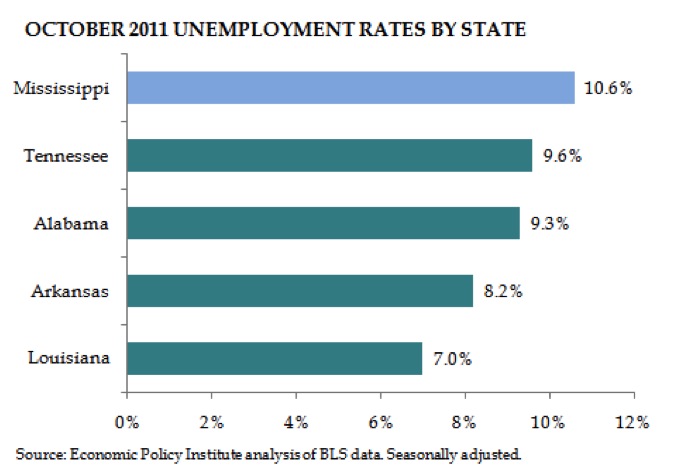JOB WATCH: Mississippi Unemployment Rate Above 10 Percent
December 5th, 2011
The national jobs report released Friday showed substantial gains in overall employment with the U.S. adding 120,000 jobs. For the first time in over 2 years, the country’s unemployment rate fell to 8.6%. The report also found that job growth in October and September was stronger than initially reported.
While November reports for states have not been released, information on unemployment for October is available. In October, Mississippi’s unemployment rate remained unchanged at 10.6 percent for the second month in a row.
Almost four years after the start of the 2007 recession, Mississippi is one of ten states that continue to experience unemployment rates above 10 percent. Only California and Nevada were reported to have higher unemployment rates in October. The graphic below shows unemployment rates for states bordering Mississippi. Louisiana and Arkansas’ rates were below the national rate of unemployment.
While the uptick in national employment and consumer sentiment are positive developments, Mississippi’s workforce still faces a long recovery to reach pre-recession levels. In total, an estimated 138,700 adults in Mississippi were jobless and looking for work in October 2011, about 10,000 more than were jobless one year ago. The depth and persistence of this recession reaches beyond previous downturns. Without a substantial change in job growth trends, it will be several years before the state’s unemployment rate returns to normal levels.
As national and state employment levels recover slowly, steps can be taken to put more of Mississippi’s working families on a path to income gains and financial security. MEPC continues to recommend building workforce training through sector initiatives and strengthening work supports like child care, health care, energy assistance and affordable housing. Only by taking a balanced approach that includes raising revenue will Mississippi have the resources to put the education and work support systems in place needed to be competitive in the global economy.
Author: Sarah Welker, Policy Analyst





